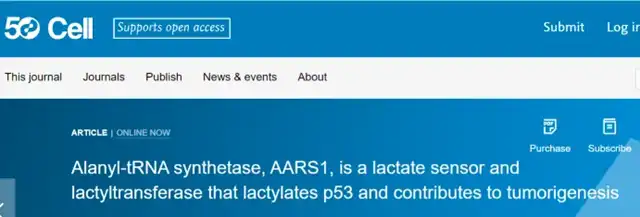What Is The Role of Lactic Acid in Tumor Growth and Therapy Resistance?
- “Miracle Weight-Loss Drug” Sweeps Across America
- The United States Avian Influenza Outbreak Worse Than Expected?
- Global First: Bovine Avian Influenza Transmission to Humans Detected
- Potassium-Enriched Salt Substitutes: Reducing Blood Pressure Risk?
- Tritium Detection in Fukushima’s Seawater: Below Safety Standards
- What Reason Let AstraZeneca Withdraws COVID Vaccine From The Market?
What Is The Role of Lactic Acid in Tumor Growth and Therapy Resistance?
- AstraZeneca Admits for the First Time that its COVID Vaccine Has Blood Clot Side Effects
- Was COVID virus leaked from the Chinese WIV lab?
- HIV Cure Research: New Study Links Viral DNA Levels to Spontaneous Control
- FDA has mandated a top-level black box warning for all marketed CAR-T therapies
- Can people with high blood pressure eat peanuts?
- What is the difference between dopamine and dobutamine?
- How long can the patient live after heart stent surgery?
What Is The Role of Lactic Acid in Tumor Growth and Therapy Resistance?
Lactic acid is not only a byproduct of tumor cell metabolism but also promotes tumor growth and spread through multiple mechanisms. Lactic acid can support the survival of tumor cells as an energy substrate, activate key signaling pathways, and promote the invasion, metastasis, angiogenesis, and immune escape of tumor cells.
Recently, researchers from Soochow University revealed the mechanism by which lactic acid promotes the growth of tumor cells. They found that alanyl-tRNA synthetase (AARS1) acts as a sensor for lactic acid and promotes global lysine lactylation in tumor cells. Specifically, a molecule called AARS1 in tumor cells also acts as a “radar” for lactic acid – AARS1 binds to lactic acid, catalyzes the formation of a lactic acid-AMP complex, promotes lactylation of the p53 protein, leading to its abnormal activity, hindering cell cycle regulation, and stimulating tumor growth.
This finding was published in *Cell* under the title “Alanyl-tRNA synthetase, AARS1, is a lactate sensor and lactyltransferase that lactylates p53 and contributes to tumorigenesis.”

One major characteristic of cancer is metabolic imbalance, which can be simply understood as the “energy-saving mode” of cancer cells. Most cancer cells prefer aerobic glycolysis (Warburg effect) even in the presence of oxygen, intentionally producing large amounts of lactic acid. This not only changes the surrounding environment but also prepares a bunch of “energy snacks” – lactic acid – for themselves.
Lactic acid not only affects biological processes such as immune cell differentiation, tumor immune surveillance, fibrosis, and ischemic injury but also regulates gene expression through protein lactylation, an epigenetic modification. However, the specific mechanism by which lactic acid is recognized and converted into protein lactylation within cells remains to be elucidated.
In this study, the research team identified numerous AARS1 target sites using proteomic methods, especially two key sites in the DNA-binding domain of p53 – lysine 120 and lysine 139 – which can be lactylated. By conducting experiments with p53 variants that simulate intrinsic lactylation status, the researchers observed that AARS1-mediated lactylation on p53 inhibits its liquid-liquid phase separation, DNA binding function, and transcriptional activation. In cancer patients with wild-type p53, high expression of AARS1 is associated with the level of p53 lactylation and poor prognosis. Animal model experiments further revealed that supplementation with beta-alanine can effectively inhibit the interaction between lactic acid and AARS1, reduce the degree of p53 lactylation, and thereby alleviate tumor development. This finding highlights the key role of AARS1 in linking the new metabolism and protein profile changes of tumor cells in the mechanism of tumorigenesis.
As a multifunctional tumor suppressor, p53 can activate multiple defense pathways to maintain cells’ resistance to cancer. Unfortunately, p53 is frequently inhibited during tumor progression, with more than half of cancers carrying mutations that impair its anti-cancer function. Additionally, the activity of p53 is finely regulated by various post-translational modifications such as phosphorylation, acetylation, and ubiquitination. Therefore, deepening the understanding of p53 regulation mechanisms may open up new avenues for cancer treatment by restoring or enhancing p53’s anti-cancer function.
Using CRISPR screening technology, this study revealed the function of AARS1 as an intracellular lactic acid sensor. It directly binds to lactic acid and catalyzes global lysine lactylation of proteins, including the p53 protein. AARS1 uses ATP to assist in generating a lactic acid-AMP intermediate, covalently linking lactic acid to lysine residues, mediating protein-level lysine lactylation.
Furthermore, it has been confirmed that alanyl-tRNA synthetase in *Escherichia coli* (EcAlaRS) can also catalyze the lactylation of eukaryotic proteins and p53 across species, indicating that the lactic acid transferase activity of AARS1 has a profound evolutionary history and high conservation. AARS1 can induce specific site lactylation of p53’s DNA binding domain, inhibit its binding to p53 response element DNA, and thus interfere with p53’s liquid phase separation and transcriptional activity. The study also proposes the use of beta-alanine to competitively bind to AARS1 to inhibit p53 lactylation, providing a new strategy for enhancing chemotherapy efficacy.
These research findings not only enrich the basic theory of protein lactylation but also directly elucidate the close relationship between metabolic product lactic acid and the development of tumors. Scientists had previously discovered that lactic acid promotes tumor growth. For example, at the end of 2023, Professor Jian Yuan’s team from Tongji Medical College/Affiliated Oriental Hospital published a paper titled “Metabolic Regulation of Homologous Recombination Repair by MRE11 Lactylation” in *Cell*, showing that lactic acid helps tumor cells evade the killing effects of chemotherapy drugs, leading to chemoresistance.

Specifically, lactic acid can promote homologous recombination repair (HR) by lactylating the key DNA repair protein MRE11, resulting in chemoresistance, as if putting a “golden bell and iron armor” on tumor cells. The low expression of lactate dehydrogenase A is related to the downregulation of HR, indicating that lactic acid is involved in HR regulation. Increasing cellular lactylation levels can promote HR repair and make tumor cells resistant. MRE11 undergoes lactylation at the K673 site under the catalysis of acetyltransferase CBP, which is its main modification site. High levels of MRE11 K673 lactylation promote DNA binding and repair, leading to resistance. Inhibiting this modification significantly enhances the efficacy of chemotherapy, indicating a potential chemotherapy synergistic strategy.
In summary, lactic acid plays multiple roles in various processes of tumors, serving as both an energy supplier, a messenger for signal transduction, and a master regulator of gene expression. Scientists are working hard to uncover the mystery of lactic acid, hoping to find more “heroes” like beta-alanine, to inhibit the effects of lactic acid or interfere with its metabolic pathways, bringing new hope for anti-tumor treatment. In the future, perhaps we can rely on these scientific discoveries to give tumor cells a “sour” counterattack in the battle against cancer!
What Is The Role of Lactic Acid in Tumor Growth and Therapy Resistance?
References:
[1]. Zong Z, Xie F, Wang S, et al. Alanyl-tRNA synthetase, AARS1, is a lactate sensor and lactyltransferase that lactylates p53 and contributes to tumorigenesis. Cell. Published online April 17, 2024. doi:10.1016/j.cell.2024.04.002
[2]. Chen Y, Wu J, Zhai L, et al. Metabolic regulation of homologous recombination repair by MRE11 lactylation. Cell. 2024;187(2):294-311.e21. doi:10.1016/j.cell.2023.11.022
(source:internet, reference only)
Disclaimer of medicaltrend.org
Important Note: The information provided is for informational purposes only and should not be considered as medical advice.



